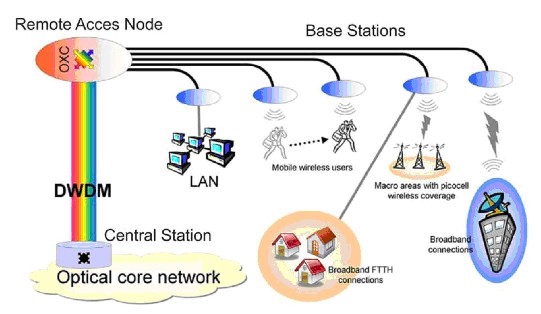Radio-over-Fiber DWDM Systems

In past decadse the data rate capacity of broadband Wireless communication technology has taken a quantum leap. While the data rate of the first digital GSM systems was limited to various kbps, modern LTE systems which are currently at the final stage of development will enable broadband communication at up to a staggering 20 Mbps per user. Further expansion in terms of data rate will necessarily lead to a limited number of users per cell. Therefore, pico as well as femto cellular networks are increasingly gaining attention in research. These systems typically work at the millimeter frequency band using carrier frequencies of 60 GHz and above, thus limiting the cell size to various metres due to the high propagation losses at such high frequency range. That obviously leads to a significantly higher number of base stations compared to currently used systems. For limiting the complexity of the wireless access network the centralisation of digital as well as analog functionality becomes a crucial issue. Due to the high transmission losses at those frequencies the distribution of the millimetre wave signal can hardly be realised using a conventional copper network. This problem can be solved by using an optical carrier transmitted over optical fibre, an approach which is known as Radio-over-Fibre.
The task of this scientific work is the efficient simultaneous generation, modulation and distribution of various millimetre wave signals in the optical frequency domain. Carrier generation is realised using an optical frequency comb with a bandwidth beyond 1 THz. The system is meant to support a number of data channels each carrying up to 10 Gbps of information.
Together with the fibre optic signal distribution a demonstrator for wireless communication at carrier frequencies up to 120 GHz shall make future wireless broadband communication an imminent reality.
Persons involved in this project:
Univ.-Prof. Dr.-Ing. C. G. Schäffer, Dr.-Ing. Reinhold Herschel
Letzte Änderung: 27. September 2017